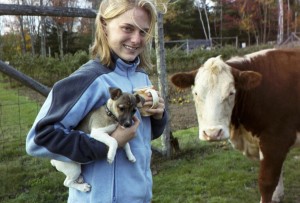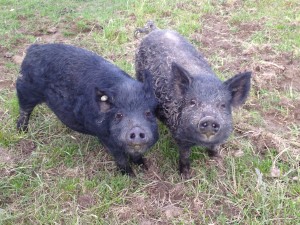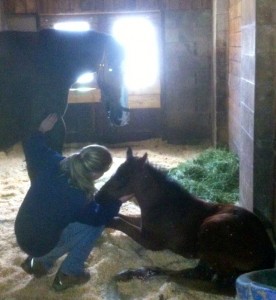To anyone who has ever sat at a desk breathing stale dry air and reading through snippy emails from their boss, Jessica Creighton, equestrian and now, sole owner and operator of her own 266-acre Freer Prospect Farm in Maine, leads an enviable life.
Far from a world of sleep deprived colleagues, her fuzzy faced farm animals and ex-racehorse Thoroughbreds all flock to see her, seeking food, yes, but providing deep reward to a young lady who works sunup to sundown making hay the old-fashioned way.
In this week’s Clubhouse Q&A, Creighton took time away from her very busy schedule to discuss how she segued from horses to Downeast farmer.
Q: Jessica, you seem like you should be the head of marketing somewhere instead are running a working farm in Maine. How did you decide on this life?
I can’t really say that it was a conscious decision; it just happened. It’s a lifestyle that I just can’t get away from— there are some days where everything is breaking, or freezing, or I want to sleep in and can’t, and a 9-5 job sounds pretty good!
But then I realize that there is no other job in this world that makes me as happy as being a farmer, and I snap out of it pretty quickly!
The challenges make the successes even more meaningful, and there is nothing more satisfying to me as working with my hands and seeing the results at the end of the day.
Q: Please describe the scope of your farm, in terms of acreage, crops, and nonhuman inhabitants.
The farm here is 266 acres— over half is in woodland, and the rest is in pasture and hayfields.
A brook forms one whole property line, and in the spring there is some great trout fishing down there.
The ground is incredibly fertile here, and the grazing and hay yields are fantastic.
I actually purchased the property from the Maine Farmland Trust, which had purchased it from the previous owners, who ran a dairy farm here.
The Trust placed an agricultural easement on the land, so it can never be developed, not even 200 years from now. It’s wonderful to know that generations from today, the fields will still be fields and not house lots.
My boyfriend and I also hayed an additional 100 acres of leased ground this past summer, which brought our total hay acreage to about 180 acres.
As far as the critters go, there are horses, pigs, dogs, cats, rabbits, chickens, turkeys, guinea fowl, ducks, geese, and Coturnix quail. I’ve got a lot of interest in incorporating the birds and pigs into a pasture rotation program similar to the one used at Polyface Farm in Virginia (if you want to spend an afternoon being inspired, check out some of Joel Salatin’s writings and YouTube videos!)
Allowing the animals to live outside with the sun on their backs and green grass in their bellies just doesn’t compare to keeping them caged inside, and they’re so much healthier.
Most of the breeds we have are heritage, rare, and have origins here in the U.S. American Guinea Hogs, Buckeye chickens, American Buff Geese, and some uncommon turkey colors.
The heritage breeds can take longer to reach adult size and don’t get as big as some of the more commercial animals, but they fit the grass farming lifestyle better, as that’s what they were designed for.
The grocery store turkeys and chickens may reach harvestable size in fraction of the time, but they’re so genetically altered that they can’t even reproduce naturally, and I’ve got no interest in supporting an industry like that. We have chickens and ducks that hatch out their own clutches of babies every year, and its so much fun to have them running around in the summer.
Q: As a farmer in New England, what would you say is the most important factor in your livelihood? And what have been your biggest challenge and your biggest success since you began?
The biggest challenge is definitely the weather!
Especially when it comes to making hay. Coastal Maine is probably one of the most difficult places in the world to get hay to cure, and this year was no different— first cut was late because of the wet spring we had, and second cut ended up being a washout because of September rain and fog.
Making sure that there’s enough hay to last the winter is certainly one of the biggest challenges, but this year I think there may be enough, which is a huge relief.
I think one of the biggest personal successes, so far, was learning how to operate all of the haying equipment this past summer. The mower conditioner and the balers always made me nervous, but I spent enough time running them this year that I feel pretty confident now.
Q: Horses and ex-racehorses are big part of your farm. Please explain how you help ex-racehorse Thoroughbreds.
All but the few homebreds that live here on the farm were produced for the racing industry—my own personal passion is helping ex-racehorses transition into new careers, or retire in comfort and safety.
We have some winners here, and some who couldn’t outrun a snail. They’re so deserving of a second chance once they have no place in the racing industry, and I’m glad that I’ve been able to offer that chance to a few of them.
Watching the whole herd gallop up across the 40-acre pasture is a sight to see!
Q: What is the most satisfying aspect of farm life?
That’s a hard question to answer— it’s all so satisfying! Knowing the animals are fed and cared for, watching the fields and the gardens grow, shutting the door on a full hay barn, eating a meal that was produced entirely on the property—it’s very hard to pick just one answer.
Knowing that the life I’m living is the life I chose and love is probably the best way to describe the whole feeling.






So glad you are involved with a Farmland trust. For those of you who are interested go the websight http://www.farmland.org which is The American Farmland Trust site. There are local trust thru out the country who focus on saving farm land for production. You do not give up ownership of your land,, You are protecting it from development.
Wow! A real life , active dream farm! I am amazed at how hard others work to make things right for the animals and the earth! I love this story! So very inspiring! Another favorite 🙂 Thank you Susan!
Ah, the life! I’d rather be doing that than the 9-5. Yes, it’s hard work, but I feel like I’m already doing that PLUS the 9-5. I keep saying I need more time at the barn–fixing fence, grooming, barn maintenance (and I’m a boarder!) If I had my own working farm, I could look out and see the horses in my own fields and not fret when the weather turns bad and I’m stuck at work, relying on someone else to watch out for them. I’m keeping my eyes peeled for a good spot, and maybe someday, I too can quit the 9-5 and have a place for re-homing OTTB’s.
Lisa and Ann, isn’t it great what she’s doing?! On so many levels, it’s just good, good work she does.
Best article EVER….Reducing your carbon footprint…eating a meal produced completely on your property…..helping horses…..making your own hay…Well done Jessica….that is we are trying to do here…working towards being as self sustainable as possible. Another great article Susan…proud to know you…..